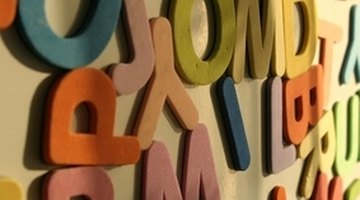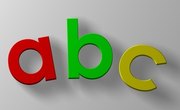There are two philosophies on teaching reading, using phonics or using whole language. Teaching through phonics means that a student will learn each sound and syllable pattern individually. Learning through whole language means developing reading skills through learning sight words and memorization. The consensus among educators is that using a combination of phonics and whole language is the best way to teach reading. However, there are many advantages to using a phonetic approach.
Sound/Symbol Recognition is Stronger
A child who learns reading through phonics will have excellent "phonemic awareness," which means that he will be able to associate letter symbols with their appropriate sound, even when letters can make more than one sound. For example, a child who learns phonics will be able to see a "p" and know that the sound is "puh." This skill will prove incredibly useful when the child is sounding out unknown words and syllables.
Sounding Out Unfamiliar Words is Easier
A child who has strong phonemic awareness can put sounds together to make syllables. For example, if a child knows, through learning phonics, that "ch" can say "chuh," or "shhh," depending on the word, he will know to try out both when sounding out an unfamiliar word. Donald R. Bear, Marcia Invernizzi, Shane Templeton and Francine Johnson, authors of "Words Their Way," argue that teaching phonics will allow students to learn the regular patterns of words, allowing for easier reading.
Knowing Spelling Patterns Makes Reading Multi-Syllabic Words Easier
Because spelling is based on sound/symbol awareness for the majority of the English language, teaching reading through phonics will develop strong spellers. A phonetic learner who is spelling a multi-syllabic word such as "conversation," will know that there is a prefix, "con," a suffix, "tion," and four syllables, each starting with a consonant and ending with a consonant. A whole-language learner would have to memorize what the word says and would not understand how to break the word apart to read or spell it.
Students Learn Syllable Structure
A student who learn phonics will become familiar with syllable structure. She will know that a closed syllable will end in a consonant and have a short vowel, while an open syllable will end in a vowel that makes a long sound. She will know that when two vowels are together in a word, the first one makes a long sound while the other stays silent. These rules, among others, are very useful in decoding and encoding words, says William H. Miller, Ed.d, author of "The Reading Teacher's Survival Kit."
Related Articles
References
- "Words Their Way"; Donald R. Bear, Marcia Invernizzi, Shane Templeton, Francine Johnson; 2004
- "The Reading Teacher's Survival Kit"; Wilma H. Miller, Ed.D; 2001.
Writer Bio
Sarahlynne Davis has been a professional educator since 2003. She holds a Bachelor of Arts in English and government from Skidmore College, a Master of Education in literacy from the University of San Diego and an English teaching license from Indiana Wesleyan University.











